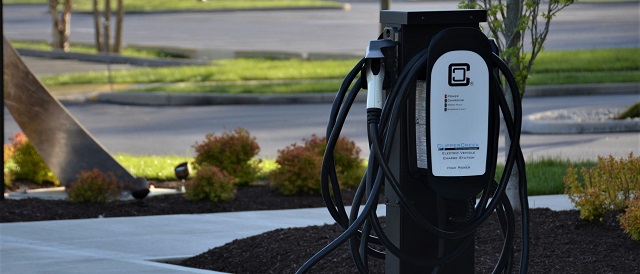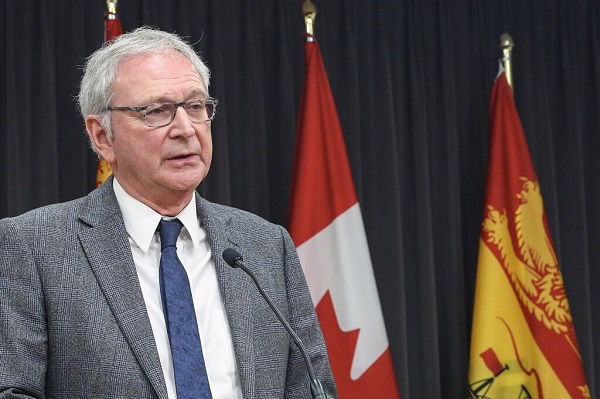Addictions
New organizations for mental health and addictions to provide focused care and take pressure off health system
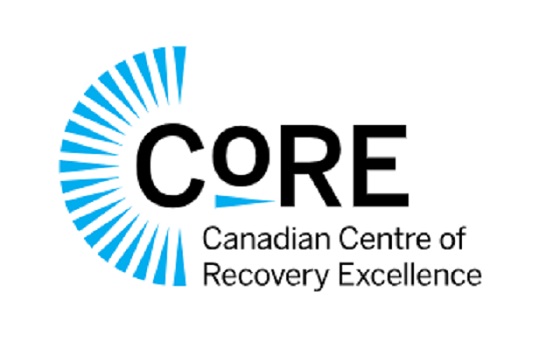
Refocusing health care: mental health and addiction
Alberta’s government is creating two new organizations that will support the development of the mental health and addiction system of care.
In November 2023, Alberta’s government announced it would be refocusing health care with the creation of four new organizations that will be responsible for the oversight and delivery of health care services in the province. The four new organizations include acute care, continuing care, primary care and mental health and addiction. The mental health and addiction organization will be the first of these to be established when it becomes an entity later this year.
The new mental health and addiction organization, Recovery Alberta, will be responsible for the delivery of mental health and addiction services currently delivered by Alberta Health Services (AHS). In addition, Alberta’s government is establishing the Canadian Centre of Recovery Excellence (CoRE) to support Alberta’s government in building recovery-oriented systems of care by researching best practices for recovery from around the world, analyzing data and making evidence-based recommendations.
“Refocusing health care enables us to better prioritize the health care and services Albertans need. Giving Albertans living with mental health or addiction challenges an opportunity to pursue recovery and live a contributing life is the responsible and compassionate thing to do. I am so proud of the work we have done to be leaders on recovery, and I am looking forward to seeing both Recovery Alberta and the Canadian Centre of Recovery Excellence continue this work for years to come.”
“Alberta is leading the country with the development of the Alberta Recovery Model to address mental health and addiction challenges. The establishment of these two new organizations will support the delivery of recovery-oriented services to Albertans and will further cement Alberta as a leader in the field. We are proud to establish Recovery Alberta and CoRE as part of the Alberta Recovery Model.”
“We’re making good progress on refocusing health care in Alberta. Today marks a pivotal milestone towards creating a system that truly serves the needs of Albertans. Through this refocused approach, our aim is to prioritize the needs of individuals and families to find a primary care provider, get urgent care without long waits, access the best continuing care options, and have robust support systems for addiction recovery and mental health treatment.”
Recovery Alberta
In August 2023, Alberta’s Ministry of Mental Health and Addiction began the process of consolidating the delivery of mental health and addiction services within AHS, a process that was completed in November 2023 with no disruption to services.
Recovery Alberta will report to the Ministry of Mental Health and Addiction and further support the Ministry’s mandate to provide high-quality, recovery-oriented mental health and addiction services to Albertans. It is anticipated Recovery Alberta will be fully operational by summer 2024 and will operate with an annual budget of $1.13 billion from Alberta’s government. This funding currently supports the delivery of mental health and addiction services through AHS.
The current provincial leadership team for Addiction and Mental Health and Correctional Health Services within AHS will form the leadership team of Recovery Alberta. When Recovery Alberta is fully established, Kerry Bales, the current Chief Program Officer for Addiction and Mental Health and Correctional Health Services within AHS will be appointed as CEO. Dr. Nick Mitchell, Provincial Medical Director, Addiction and Mental Health and Correctional Health Services within AHS, will become the Provincial Medical Director for Recovery Alberta.
“Recovery Alberta will build on the strong foundation of existing mental health and addiction services that staff and clinicians deliver. By working closely with Alberta Mental Health and Addiction and the Canadian Centre of Recovery Excellence, Recovery Alberta will continue to set a high standard of care for mental health and addiction recovery across the province, and beyond.”
“Albertans deserve patient-centered care when and where they need it. By establishing Recovery Alberta, we have an opportunity to work together in a new way to make that a reality for our patients and our communities.”
While timelines are dependent on legislative amendments yet to be introduced, the Ministry of Mental Health and Addiction is aiming to establish the corporate structure of Recovery Alberta by June 3. Following the establishment of the corporate structure and executive team, staff and services would begin operation under the banner of Recovery Alberta on July 1.
Frontline workers and service providers will continue to be essential to care for Albertans. To ensure stability of services to Albertans, there will be no changes to terms and conditions of employment for AHS addiction and mental health staff transitioning to Recovery Alberta. Additionally, there will be no changes to grants or contracts for service providers currently under agreement with AHS upon establishment of Recovery Alberta.
Canadian Centre of Recovery Excellence (CoRE)
Alberta’s government has been leading the country in creating a system focused on recovery by building on evidence-based best practices from around the world. In five years, Alberta has removed user fees for treatment, increased publicly funded treatment capacity by 55 per cent and built two recovery communities with nine more on the way. Alberta’s government has also pioneered new best practices such as making evidence-based treatment medication available same day with no cost and no waitlist across the province through the Virtual Opioid Dependency Program.
To continue the innovative work required to improve the mental health and addiction system, Alberta’s government is creating the Canadian Centre of Recovery Excellence to inform best practices in mental health and addiction, conduct research and program evaluation and support the development of evidence-based policies for mental health and addiction. CoRE will be established as a crown corporation through legislation to be introduced this spring.
Alberta’s government has committed $5 million through Budget 2024 to support the establishment of CoRE. It is anticipated CoRE will be operational by this summer.
The CoRE leadership team will consist of Kym Kaufmann, former Deputy Minister of Mental Health and Community Wellness in Manitoba as the CEO. She will be supported by Dr. Nathaniel Day as Chief Scientific Officer of CoRE. Dr. Day currently serves as the Medical Director of Addiction and Mental Health within AHS.
“There is a need for more scientific evidence on how best to help those impacted by addiction within our society. The Canadian Centre of Recovery Excellence will generate new and expanded evidence on the most effective means to support individuals to start and sustain recovery.”
“The Canadian Centre of Recovery Excellence will provide the research and data we need to understand what works best when it comes to recovery. This new expertise and expanded evidence will provide us with further insight into how we can support communities, service providers and frontline staff to effectively help those living with addiction and mental health challenges.”
Quick facts
- Budget 2024 will invest more than $1.55 billion to continue building the Alberta Recovery Model.
- This includes a $1.13 billion transfer from Health to Mental Health and Addiction (MHA) for mental health and addiction services currently delivered by Alberta Health Services.
- Virtual engagement sessions for AHS staff and service providers will be held on April 11, 16, 17 and 22.
Related information
Addictions
Poilievre attacks decriminalization of hard drugs with Safe Hospitals Act
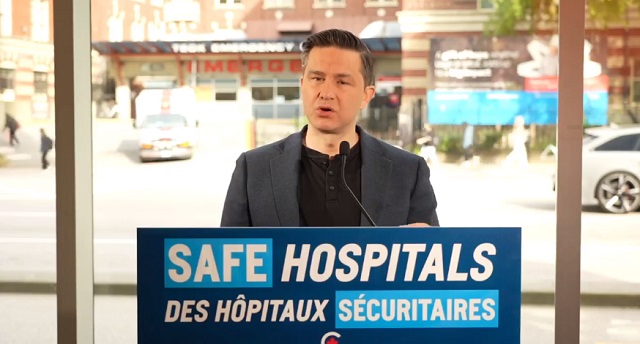
New release from the Conservative Party
The Hon. Pierre Poilievre, Leader of Canada’s Common Sense Conservatives, announced his plan today to ban dangerous weapons and drugs and punish those who harm doctors and nurses.
The Problem:
After nine years, Justin Trudeau’s radical experiment of decriminalizing hard drugs has failed. Since Trudeau formed government, over 42,000 Canadians have died from drug overdoses. Nanaimo, for example, has seen a nearly 400 percent increase in drug overdose deaths in the last four years alone, yet Trudeau decided to allow opioids, cocaine, heroin, and methamphetamine to be used in public places like hospitals and parks anyway.
The results of this experiment have been catastrophic. Chaos and disorder have reigned free in public spaces across British Columbia. Our once-safe hospitals are being destroyed by criminals and hard drugs, with the B.C. Nurses Union ringing the alarm bell, saying that patients and staff have been exposed to harmful, illegal drugs. The BC Nurses Union also reported that meth was being smoked in a unit just hours after the birth of a newborn baby. In northern British Columbia, the public health agency put out a memo telling hospital staff to allow patients to bring knives and other weapons into hospitals.
Life became so miserable that BC’s radical NDP Premier asked Justin Trudeau to walk back parts of his wacko decriminalization policy. But the Liberals haven’t learnt from their mistakes.
The Cause:
Two years ago, the Liberal Government granted the BC NDP Government’s request to allow hard drugs across the province, including in public spaces. In the first year of this reckless experiment, 2,500 Canadians died from drug overdoses. Meanwhile, community spaces like soccer fields, hospitals and city squares have been devastated by crime and disorder.
But Justin Trudeau refuses to rule out the requests from Toronto Public Health and the City of Montreal to allow hard drugs in Canada’s two largest cities. He also won’t say whether hard drugs should be allowed in children’s parks, hospitals and public transit. On top of this, the Liberal Minister of Mental Health refuses to acknowledge that their dangerous experiment was a failure.
The Solution:
Common Sense Conservatives will not allow this devastating experiment to play out in other Canadian communities. Canadians deserve a government that will keep hard drugs out of hospitals and will protect staff and patients. We will:
- Create an aggravating factor for the purposes of sentencing if a criminal has a weapon in a hospital.
- End the Health Minister’s power to grant exemptions under s.56 of the Controlled Drug and Substances Act if the exemption would allow people to use dangerous illicit drugs like fentanyl and meth in hospitals. This means that even if Trudeau grants Toronto and Montreal’s request to decriminalize hard drugs, our hospitals will be protected.
- Immediately pass Common Sense Conservative MP Todd Doherty’s Bill C-321, which will create an aggravating factor for assault committed against healthcare workers or first responders.
To be clear, the ban would not apply to any drugs prescribed by medical practitioners like doctors and nurses.
The Safe Hospitals Act will stop some of the insanity that Justin Trudeau and the NDP have unleashed on Canadians with their plan to decriminalize the public use of hard drugs everywhere in Canada. A Poilievre government will ban hard drugs, stop giving out taxpayer-funded opioids, and reinvest that money in treatment and recovery so we can bring home our loved ones drug-free.
Poilievre said:
“Justin Trudeau’s decriminalization experiment has failed. It has resulted in death, misery and destruction across British Columbia, while our hard-working nurses live in fear of inhaling dangerous drugs or being attacked by criminals.
“Instead of learning from this catastrophic mistake, Trudeau has doubled down. He’s refusing to reject Toronto and Montreal’s request to allow hard drugs like fentanyl and heroin to be used in Canada’s two biggest cities.
“Common Sense Conservatives will keep doctors, nurses and patients safe, even if Justin Trudeau won’t. The Liberals and NDP must vote for this common sense Bill until we can form a government that ends this deadly hard drug decriminalization experiment for good.”
Addictions
Canada’s ‘safer supply’ patients are receiving staggering amounts of narcotics
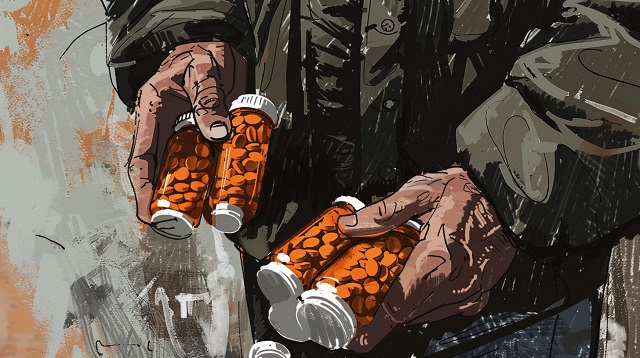
Image courtesy of Midjourney.
|
|
How a Small Population Fuels a Black Market Epidemic, Echoing Troubling Parallels in Sweden
A significant amount of safer supply opioids are obviously being diverted to the black market, but some influential voices are vehemently downplaying this problem. They often claim that there are simply too few safer supply clients for diversion to be a real issue – but this argument is misleading because it glosses over the fact that these clients receive truly staggering amounts of narcotics relative to everyone else.
“Safer supply” refers to the practice of prescribing free recreational drugs as an alternative to potentially-tainted street substances. In Canada, that typically means distributing eight-mg tablets of hydromorphone, an opioid as potent as heroin, to mitigate the use of illicit fentanyl.
There is clear evidence that most safer supply clients regularly sell or trade almost all of their hydromorphone tablets for stronger illicit substances, and that this is flooding communities with the drug and fuelling new addictions and relapses. Just five years ago, the street price of an eight-mg hydromorphone tablet was around $20 in major Canadian cities – now they often go for as little as $1.
But advocates repeatedly emphasize that, even if such diversion is occurring, it must be a minor issue because there are only a few thousand safer supply clients in Canada. They believe that it is simply impossible for such a small population to have a meaningful impact on the overall black market for diverted pharmaceuticals, and that the sudden collapse of hydromorphone prices must have been caused by other factors.
This is an earnest belief – but an extremely ill-informed one.
It is difficult to analyze safer supply at the national level, as each province publishes different drug statistics that make interprovincial comparisons near-impossible. So, for the sake of clarity, let’s focus primarily on B.C., where the debate over safer supply has raged hottest.
According to a dashboard published by the British Columbia Centre for Disease Control, there were only 4,450 safer supply clients in the province in December 2023, of which 4,250 received opioids. In contrast, the 2018/19 British Columbia Controlled Prescription Drug Atlas (more recent data is unavailable) states that there were approximately 80,000 hydromorphone patients in the province that year – a number that is unlikely to have decreased significantly since then.
We can thus reasonably assume that safer supply clients represent around 5 per cent of the province’s total hydromorphone patients – but if so few people are on safer supply, how could they have a profound impact on the black market? The answer is simple: these clients receive astonishing sums of the drug, and divert at an unparalleled level, compared to everyone else.
Safer supply clients generally receive 4-8 eight-mg tablets per day at first, but almost all of them are quickly moved up to higher doses. In B.C., most patients are kept at 14 tablets (112-mg in total) per day, which is the maximum allowed by the province’s guidelines. For comparison, patients in Ontario can receive as many as 30 tablets a day (240-mg in total).
These are huge amounts.
The typical hydromorphone dose used to treat post-surgery pain in hospital settings is two-mg every 4-6 hours – or roughly 12-mg per day. So that means that safer supply clients can receive roughly 10-20 times the daily dose given to acute pain patients, depending on which province they’re located in. And while acute pain patients are tapered off hydromorphone after a few weeks, safer supply clients receive their tablets indefinitely.
Some chronic pain patients (i.e. people struggling with severe arthritis) are also prescribed hydromorphone – but, in most cases, their daily dose is 12-mg or less. The exception here is terminally ill cancer patients, who may receive up to around 100-mg of hydromorphone per day. However, this population is relatively small, so we once again have a situation where safer supply patients are, for the most part, receiving much more hydromorphone than their peers.
Not only do safer supply patients receive incredible amounts of the drug, they also seem to divert it at much higher rates – which is a frequently overlooked factor.
The clandestine nature of prescription drug diversion makes it near-impossible to measure, but a 2017 peer-reviewed study estimated that, in the United States, up to 3 per cent of all prescription opioids end up on the black market.
In contrast, it appears that safer supply patients divert 80-90 per cent of their hydromorphone.
These numbers should be taken with a grain of salt, as there have been no attempts to measure safer supply diversion – harm reduction researchers tend to simply ignore the problem, which means that we must rely on journalistic evidence that is necessarily anecdotal in nature. While this evidence has its limits, it can, at the very least, illustrate the rough scale of the problem.
For example, in London, Ontario, I interviewed six former drug users last summer who said that, of the safer supply clients they knew, 80 per cent sold almost all of their hydromorphone – just one interviewee placed the number closer to 50 per cent. More recently, I interviewed an addiction outreach worker in Ottawa who estimated that 90 per cent of safer supply clients diverted their drugs. These numbers are consistent with the testimony of dozens of addiction physicians who have said that safer supply diversion is ubiquitous.
Let us take a conservative estimate and imagine that only 30 per cent of safer supply hydromorphone is diverted – even this would be potentially catastrophic.
So we can see why any serious attempt to discuss safer supply diversion cannot narrowly focus on patient numbers – to ignore differences in doses and diversion rates is inexcusably misleading.
But we don’t need to rely on theory to make this point, because the recent parliamentary testimony of Fiona Wilson, who is deputy chief of the Vancouver Police Department and president of the B.C. Association of Chiefs of Police (BCACP), illustrates the situation quite neatly.
Wilson testified to the House of Commons health committee earlier this month that half of the hydromorphone recently seized in B.C. can be attributed to safer supply. As she did not specify whether the other half was attributed to other sources, or simply of indeterminate origin, the actual rate of safer supply hydromorphone seizures may actually be even higher.
As, once again, safer supply clients constitute roughly 5 per cent of the total hydromorphone patient population, Wilson’s testimony suggests that, on a per capita basis, safer supply patients divert at least 18 times more of the drug than everyone else.
This is exactly what one would expect to find given our earlier analysis, and these facts, by themselves, repudiate the argument that safer supply diversion is insignificant. When a small population is at least doubling the street supply of a dangerous pharmaceutical opioid, this is a problem.
The fact that so few people can cause substantial, system-wide harm is not unprecedented. In fact, this exact same problem was observed in Sweden, which, from 1965-1967, experimented with a model of safer supply that closely resembled what is being done in Canada today. A small number of patients – barely more than a hundred – were given near-unlimited access to free recreational drugs under the assumption that this would keep them “safe.”
But these patients simply sold the bulk of their drugs, which caused addiction and crime rates to skyrocket across Stockholm. Commentators at the time referred to safer supply as “the worst scandal in Swedish medical history,” and, even today, the experiment remains a cautionary tale among the country’s drug researchers.
It is simply wrong to say that there are too few safer supply clients to cause a diversion crisis. People who make this claim are ignorant of contemporary and historical facts, and those who wish to position themselves as drug experts should be mindful of this, lest they mislead the public about a destructive drug crisis.
This article was originally published in The Bureau, a Canadian publication devoted to using investigative journalism to tackle corruption and foreign influence campaigns. You can find this article on their website here.
-

 Brownstone Institute2 days ago
Brownstone Institute2 days agoMedical Elites’ Disgrace Over Ivermectin
-

 conflict1 day ago
conflict1 day ago‘It Makes No Sense’: Experts Puzzled By Biden Admin’s Claim That Rafah Invasion Wouldn’t Help Israel Defeat Hamas
-

 COVID-191 day ago
COVID-191 day agoThe New York Times Admits Injuries from COVID-19 Shots
-

 Bruce Dowbiggin1 day ago
Bruce Dowbiggin1 day agoWhy Do The Same Few Always Get The Best Sports Scoops?
-

 Opinion2 days ago
Opinion2 days agoThe American Experiment Has Gone Down In Flames
-

 Energy1 day ago
Energy1 day agoFederal government continues to reject golden opportunities to export LNG
-

 Energy1 day ago
Energy1 day agoBuckle Up for Summer Blackouts: Wind Is Already Failing Texas in Spring
-

 COVID-191 day ago
COVID-191 day agoFormer COVID coordinator Deborah Birx now admits jabs could have injured ‘thousands’


